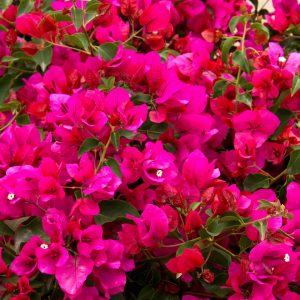Semi-Tropicals
October is the last month to plant tropicals like Allamanda, Ti plants, Crotons, Bougainvillea, and Helichonia. Planted by the end of the month, they have adequate time to establish a good root system to re-emerge from, if they receive freeze damage this coming winter. Fertilize your flowering tropicals with Nurserymen SureGro Bloomer 6-8-10 to keep them flowering through the fall.
Many customers come in complaining about their bougainvillea – won’t bloom or losing leaves etc. Bougainvillea requires full sun and drier conditions to thrive. It is generally a low maintenance plant and it is not uncommon, after a particularly lush blooming period, for the plant to lose leaves. This usually happens right before a growth spurt which will again, produce new flowers.
The leaves of your Plumeria may start to fall as we move farther into the fall as well. Bridal Bouquet doesn’t usually defoliate but it is pretty common with other varieties. Fungus from the summer is usually the cause but not to worry- it won’t hurt the plant. It will leaf out again in the spring.
Potted Plants
It is time to evaluate your potted plants – indoor and patio. If they are root bound repot in larger containers. Use fresh potting soil and fertilize with a liquid fertilizer or a granular. If you plan on bringing plants inside, spray them with soapy water or Horticultural Oil to get rid of any insects before bringing them inside.
Water
As the possibility of tropical weather approaches, continue to monitor how much water your garden is getting. If we do get significant rain- turn off your irrigation system, if it isn’t already. In addition, don’t forget to empty any standing water in your garden and flush out your bird baths and bromeliads every week to avoid mosquito populations.
Florida Friendly Landscaping
The University of Florida “Florida-Friendly Landscaping” intent is to use resource-efficient plants and sustainable maintenance practices to conserve water and reduce negative impacts on water bodies and wildlife habitats”. Essentially that boils down to “right plant, right place”, which means choosing resource-efficient plants (those that require less water, pesticides and fertilizer) that will grow and remain healthy with minimal care under the site conditions.
Florida Friendly Principles include:
• Choose the right plant for the right place
• Reduce turf to a small but functional area and replace large turf areas with low, spreading groundcover or plants
• Plant trees for shade on the east, west and south side of the house
• Shade the AC unit with a tree
• Direct water flow in the yard and use plants to catch and filter rainwater before it flows into water bodies or the storm water system.
• Use plants to attract wildlife
• Specialty gardens such as butterfly gardens can be created by grouping plants to provide food and shelter
• Incorporate mulched areas, gravel areas, pathways and patios in the yard to provide access and organization.
Being Florida Friendly does not necessarily mean using only native Florida plants either. There are many Florida Friendly plants that are not native. Essentially, trying to have a Florida Friendly yard is landscaping so the plants do not require excessive maintenance, care or water. Also, Florida Friendly gardening is protecting our natural water sources from any runoff or allowing fertilizers or chemicals to leach into our water systems.
*See University of Florida- Florida Friendly Landscaping for more information.
The best advice we can give all our new customers and all of our existing customers- ask a lot of questions and plan at the outset of any new garden and you will be successful! We at VerdeGo will be happy to answer your questions honestly and correctly.
Remember: “Gardening is a way of showing you believe in tomorrow!” Happy Planting!
